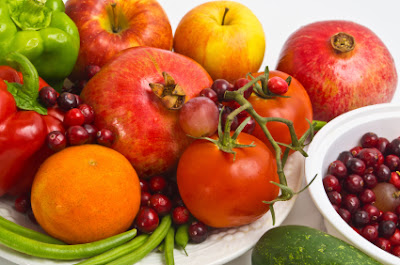Food comes in all colors found in the visible spectrum. The natural colors we see in foods enhance the experience of eating. Truthfully, we enjoy seeing the colors before even tasting the food—from the farm to the market and finally our kitchen table. They do more than paint our plate, however. They provide a palette of nutrients. A unique nutritional profile is packaged inside each colorful fruit or vegetable.
Just as it’s important to eat a variety of colors, it’s important to eat a variety of red foods to get all the rich, unique nutritional benefits from each one. Find a way to incorporate some of these red fruits and vegetables into your personal diet:
The Cherry: Heart-Shaped & Heart-Healthy
From the royal Rainier to the tart Montmorency, there are a variety of cherries to choose from. They are mainly divided up as sweet or sour cherries. Both contain antioxidant, anticancer, and anti-inflammatory properties. Compared to sour cherries, sweet ones have higher sugar content. Sour cherries have a higher antioxidant profile than sweet ones, but both are packed with folate, vitamins A, C, E, and K. Also, they have lutein and zeaxanthine, which help reduce the risk of macular degeneration and cataracts. They contain minerals such as calcium, magnesium, and phosphorus.
Cherries prove to be potent nutritional superstars. The antioxidants known as anthocyanins (which impart the red color) found in cherries are more active than those found in other berries, such as blackberries and blueberries.
Next time you toss a salad, include some whole cherries for a sweet or tart accent. Add them to your yogurt, as a side dish for your whole grains, or enjoy a Chocolate Cherry or Cherry Ripe EnergyFirst Protein Shake.
Beat & Defeat Disease with Beets
Red beets are another powerful detoxifier found in the grocery aisles. Beets are a more humble fruit—they come in no fancy shape and may be a little rough on the edges. But don’t let that earthy look discourage you. They are an excellent source of folate, iron, manganese, potassium, fiber, and even a source of protein. The Ancient Greeks valued their wild beets so much they’d offer it to their gods. A recent study done by the Department of Nutrition and Dietetics at Saint Louis University found that athletes who consumed whole beetroot improved their running performance.
The potent pigment that makes beets popular is called betanin (sound familiar? Beet? Betanin?). A part of the anthocyanin family, betanin is known for being an exceptionally active antioxidant. It has the potential of being 1.5-2 times more active than other members of the anthocyanin family.
Add warm, roasted beets in a fresh salad, as a side-dish to your favorite whole grain dish, or for a hot soup. I like to save the green leaves for an extra dose of Vitamin A, C, calcium, and iron. Use a juicer to make 100% beet juice and mix it with the energizing superfood Greenergy blend.
Tomato, Tomato
A versatile vegetable, the tomato comes in more than 7,000 varieties. Most people appreciate it for its lycopene content. Lycopene, a carotenoid or pigment that actually protects the plant from damage by light and oxidation, has been found to significantly cut the risk of prostate cancer in men. It also protects your immunity, vision, and heart. Since lycopene is a pigment in the tomato, the redder the tomato, the higher the concentration. Organic, high-quality tomatoes will offer the best nutritional profile.
Tomatoes also contain remarkable levels of beta-carotene, needed to form Vitamin A, vitamin B3, C, E, and potassium. A vitamin C-rich diet will help combat viral infections. Interferon, an anti-viral chemical, needs Vitamin C in order to be produced and secreted throughout the body.
Tomatoes are an easy ingredient to sneak into our diet. Sprinkled with herbs, they bake well as a side dish. Chop them in a spicy, fresh salsa. Stuff them with your favorite tuna or chicken salad.
Other wonderful, edible fruit warriors painted in red include cranberries, red raspberries, strawberries, red grapes. Toss these berries into a leafy green salad. Don’t forget blood oranges, pomegranates, grapefruit, watermelon, and goji berries. Dice some Red Delicious or Granny Smith apples into your favorite chicken or tuna salad.
Red vegetables include red onions, radishes, red peppers, kidney beans, red cabbage, radicchio, and rhubarb (turn this vegetable into a sweet treat and try Raspberry Rhubarb Magic protein shake).
References
Cherry Antioxidants: From Farm to Table. Gianna Ferretti, Tiziana Bacchetti , Alberto Belleggia and Davide Neri Molecules 2010, 15, 6993-7005; doi:10.3390/molecules15106993
Whole beetroot consumption acutely improves running performance. J Acad Nutr Diet. 2012 Apr;112(4):548-52. doi: 10.1016/j.jand.2011.12.002.
Betanin, the main pigment of red beet: molecular origin of its exceptionally high free radical-scavenging activity. Food Addit Contam. 2006 Nov;23(11):1079-87.Gliszczyńska-Swigło A, Szymusiak H, Malinowska P.
